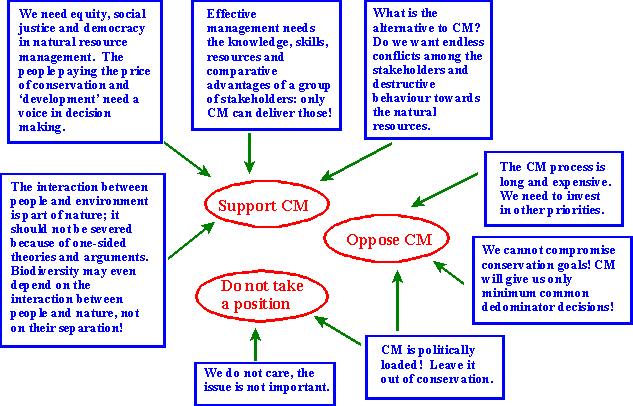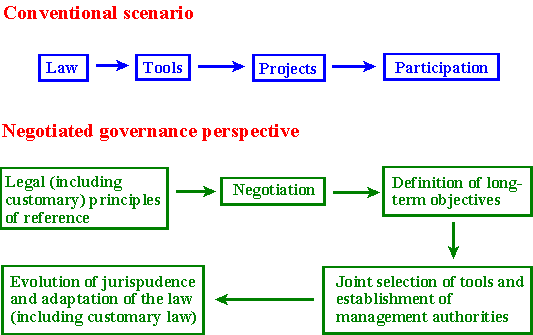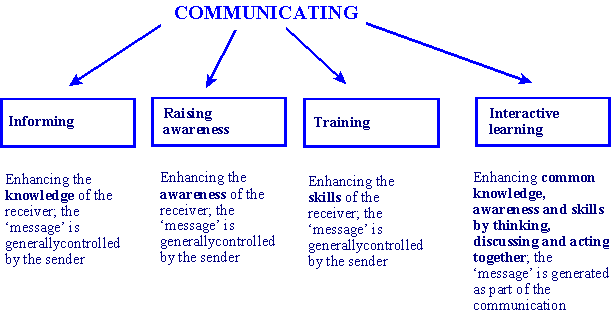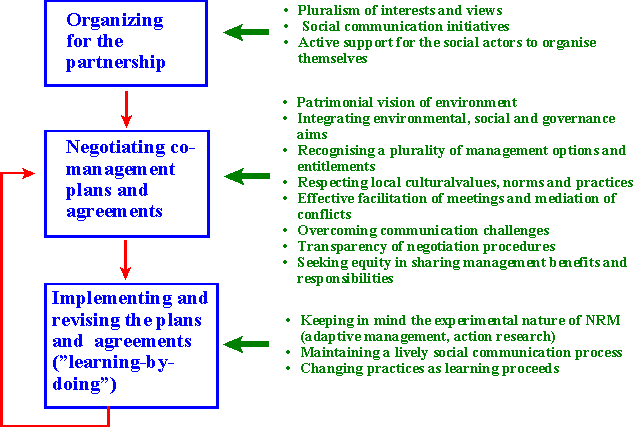
Figure: Some arguments for and against CM
Main CM values and principles
- recognising different values, interests and concerns involved in managing a territory, area or set of natural resources, both outside the local communities and within them
- being open to various types of NRM entitlements beyond the ones legally recognised (such as private property or government mandate)
- seeking transparency and equity in natural resource management
- allowing the civil society to assume ever more important roles and responsibilities
the above lead to
natural resource management PARTNERSHIPS
- harnessing the complementarity of the capacities and comparative advantages of different institutional actors
- linking entitlements and responsibilities in the NRM context
- appreciating that the process is more important than the short-term products
- learning-by-doing through on-going revisions and improvements in NR management
There are no blueprints or universally applicable paths for a CM initiative. On the contrary, there is an enormous variety of options depending on specific contexts. However, to allow for comparisons and to break down the process into manageable units, four key CM components and three main phases in a CM process can be identified:
Four inter-related CM components
|
à |
CM context |
|||
|
à |
CM process |
|||
|
à |
CM plan(s) and agreement(s) |
|||
|
à |
CM organisation(s) |
Three main phases in a CM process
- Preparing for the partnership (organising)
- Negotiating co-management plans and agreements
- Implementing and revising the plans and agreements (learning by doing)
1.2 Concepts and approaches contributing to understanding and practicing co-management
Many other relevant concepts and practices � such as participatory action research, environmental stewardship, gestion du terroir, etc. � exist, but will not be explored here.
Concepts and approaches à
adaptive management
| 'adaptive management' --- an approach based on the recognition that the management of natural resources is always experimental, that we can learn from implemented activities, and that NRM can be improved on the basis of what has been learned |
The adaptive management approach is based on scientific findings about natural ecosystems and on field-based experience gained in several environments. These lead to acknowledge the lack of unequivocal and definitive knowledge of the ways in which ecosystems work, and the uncertainty that dominates our interaction with them. The central tenet of adaptive management is thus an open, investigative and analytical attitude. Adaptive NRM activities state explicitly what they aim to achieve, specify indicators and monitoring and evaluation methods and are modified as learning proceed (see Holling 1978, and Wilston 1986).
Basic elements of adaptive management
- explicit NRM objectives and explicit hypotheses on how they are to be achieved (including monitoring indicators),
- prompt collection of data (monitoring indicators),
- on-going evaluation of monitoring data and NRM results,
- coherent changes in NRM practice in line with the results obtained and the lessons learned.
The stages of adaptive management (adapted from Taylor, 1998)
- appraisal of the NRM situation and problems, generally in workshops, with several institutional actors
- design of NRM activities, also generally in workshops, on the basis of a comparison of several possible options,
- implementation of NRM activities closely following the chosen plan (which may include zoning the land and experimenting with different activities in different zones� a procedure known as "active management"),
- monitoring the achievement of the expected results on the basis of indicators drawn up for the expected changes,
- evaluation of results to test the effectiveness of the activities implemented,
- adjusting activities in line with lessons learned; this may include the re-formulation of the problems, the NRM objectives, the activities and indicators, etc.
all of the above stages have to be documented and communicated, to share and disseminate the acquired information; this is particularly important in the case of long-term initiatives (key persons may change their jobs, but the learning should not leave with them ...
Concepts and approaches à pluralism
| 'pluralism' --- a situation in which autonomous and independent (inter-dependent) groups freely interact and collaborate on management issues on the basis of different views, interests and 'entitlements'. |
A pluralist approach focuses on recognising, acknowledging and involving the various actors, interests, concerns and values that exists in any society with respect to almost any subject. In particular:
- there are different categories of social actors � for example governmental and non-governmental, groups and private individuals, local communities and outsiders with entitlements to local resources � bearing important complementary capacities for natural resource management.
- communities are social actors in themselves and provide the most natural and effective unit of identity, integration and defence for many under-privileged groups and individuals (see Farvar, 1999). Yet, communities are not homogenous entities, and their internal sub-divisions should be recognised. In other words, while keeping their basic cohesion and identity, a plurality of values, interests and concerns should be recognised within any local community (see Agrawal, 1997).
A multiplicity of views and voices in the negotiation process is a fundamental pre-condition for equity and justice. Yet, it does not follow from this that all views and voices are equal, that they all carry the same weight or are all equally entitled to participate in the negotiation of the co-management plans and agreements.
equity is profoundly different from equality!
Concepts and approaches à governance
| 'governance' --- the complex of different ways by which individuals and institutions, public and private, manage their common concerns'. |
Good governance depends on the legitimacy of the political system and on the respect shown by the people for its institutions. It also depends on the capacity of such institutions to respond to problems, and to achieve social consensus through agreements and compromise.
Governance:
- is neither a system of rules nor an activity; it is a process
- is not based on domination but on compromise
- involves both private and public actors
- is not necessarily formalised, and is generally based on an on-going interaction (Smouts, 1998)

A comparison adapted from Karsenty (1998):
| 'patrimony' --- "the compendium of all material and immaterial elements that help maintain and develop the identity and autonomy of its owner, through time and space, by adaptation to its evolutionary context" (Ollagnon, 1991) |
A patrimonial representation of a territory, an area or a set of resources
- links past, present and future generations of managers;
- focuses on the owner�s obligations more than on the owner�s rights;
- promotes a common vision of sustainability that reconciles the needs and opinions of various actors.
Distinctive features of the notion of patrimony in comparison with the notion of property (Karsenty and Marie, 1998)
|
property |
patrimony |
|
rights of owner |
obligations of owner |
|
mobility of goods (real-estate market) |
predestination of goods (obligation of use) |
|
market value determined at present time |
value of use determined by passage of time |
|
impersonal |
constituent component of owner�s identity |
Various stages of patrimonial mediation (adapted from Weber, 1998)
- Launching: identifying actors, debating current trends for the status of natural resources and the acceptability of such trends; communicating one�s own point of view and listening to the points of view of others.
- Establishing long-term patrimonial objectives and legitimating them by culturally appropriate "rituals" that make them inalienable, non-negotiable and difficult to violate.
- Elaborating medium-term NRM scenarios by the actors, to achieve their patrimonial objectives; defining acceptable resource uses, as well as access and control; agreeing on tools, methods, responsibilities and needed technical support.
- Setting up NRM organisations: deciding on executive, decision-making and advisory bodies and their operating rules (on the basis of a discussion of the variety of possible types); legitimising but not ritualising the specific NRM bodies, rules and adopted strategies.
(from Babbit et al. 1994)
| 'conflict management' --- guiding conflicts towards constructive rather than destructive results |
Conflict management is a non-violent process that promotes dialogue and negotiation. It implies:
- taking care of disagreements before they generate hostility
- helping the institutional actors to explore a multiplicity of options for agreement and subsequently select an option everyone can live with
- recognising and intervening in the underlying causes of conflict, with a view to preventing them in the future
Modern processes of conflict management are quite close to the processes used to negotiate a co-management agreement; both express the same values (dialogue, transparency, pluralism, fairness, etc.), have the same main constituents and can be facilitated in similar way.
Main constituents of modern conflict management approaches
- the social actors concerned
- a common area of interest and some points of conflict (different values, interests and needs of the various actors involved)
- a forum for negotiation and some basic rules providing a framework for the actors concerned to meet and discuss issues together
- some reliable data on the points of conflict
- various options for action generated by the actors concerned and discussed among themselves
- a written agreement on one of these options
- the legitimisation of the agreement
- the implementation of the agreement
Many traditional systems of conflict management obtained effective results via values, constituents and processes that do not fit the above description and list. Such culturally specific ways (which may use a variety of methods and techniques, from non-verbal social pressure to trance induction, from chance decisions to linguistic reframing of issues) should be recognised and responded to in a sensitive and inclusive manner. If they are sufficient and effective to deal with the conflicts at hand, by all means they should be preferred. However, when traditional systems do not suffice and/or when conflicts involve a variety of non-traditional partners, it may be appropriate to consider the modern approaches as well.
Whenever the conflicts are serious and the parties involved are distant and hostile, the presence of a facilitator, mediator or arbiter is highly recommended. A conflict-management instructor could also be called upon. Their role is similar, but not exactly the same (see below). These key figures in conflict management are often private individuals (religious leaders, retired judges, local wise-men and women, etc) possessing special characteristics and capacities (see also Section 3.1).
facilitators
assist only in the running of the process. They never allow themselves to be drawn into the arguments.
mediators
act as facilitators, but also help develop a wide range of options for the parties to discuss and choose from. They help conflicting parties to reach an agreement satisfactory for everyone.
arbitrators
act as judges: they listen to the various parties, review pertinent documents and issue a decision, which is treated by all concerned as an expert opinion or an obligation, depending on what was decided in advance.
instructors
help the parties (usually in separate sessions) to learn the elements of conflict management, which the parties will hopefully succeed in applying to their own conflict situation.

Some suggestions on how to overcome such special circumstances are offered in Section 6 but they do not, unfortunately, come with a no guarantee of success. Below are five main checkpoints for effective conflict management (adapted from Lewis, 1996):
- Shift the attention from positions to underlying interests. "Interests" are people�s fundamental needs and concerns. "Positions" are the proposals that they put forward to try to satisfy those interests. Since many different positions can satisfy the same basic interest, focusing on interests can open up the way for conciliation and compromise.
- Appreciate the merits of fair compromise. A conflict-management effort in which all interests are satisfied is much more likely to result in a lasting and satisfactory resolution than one that addresses the interests of only one side. A fair compromise may be the best way to serve everyone�s needs in the long run, especially when overt conflict is replaced with the stability and predictability of a mutually agreeable solution. On the other hand, an unfair compromise, which may seriously curtail the entitlements of one or more social actors without effective compensation, may just be a recipe for brewing even more serious conflicts in the long run.
- Address both the procedural and substantive dimensions of conflicts. Procedural issues can include a group�s need to be included in decision-making, to have their opinions heard and to be respected as a social entity. "Substantive" refers to interests that relate to tangible products, such as availability of firewood, protection from predatory animals or stopping a major source of pollution.
- Include all significantly affected institutional actors in devising solutions. Failure to involve all affected stakeholders in conflict management generally leads to unsustainable solutions and to new conflicts arising in the future.
- Understand the power of various institutional actors, and take that into account in the process. There are often extreme differences in power between different stakeholders. Each party�s approach to the conflict will depend on their view of the power they have in relation to the other stakeholders. For example, a group that feels powerless to influence an outcome through a bureaucratic process may choose to use illegal activities instead.
| 'social communication' --- bringing understanding withina human community, exhanging messges (communicating) to create meaning and enrich common knowledge, often in order to face change (adapted from Ramirez 1997) |
It is people who bring about development and manage natural resources. There can be no change for the better without involving them, mobilising their capacities and energies and enhancing their knowledge and skills. Communication caters to all these human dimensions and is vital for any activity in which the participation of local people is envisaged and sought. In addition, effective communication generally has remarkable personal effects, such as raising morale, enhancing the sense of one�s own value and dignity, and promoting social solidarity and collaboration.
Communication may be personal (one-to-one), inter-personal (among a few individuals) and social (when it involves social groups, such as a local community). Social communication for co-management initiatives is about providing the conditions for informed decision-making in society, i.e. fostering the sharing of information and the discussion of problems, opportunities and alternative options for action. It is a generally a complex phenomenon, including a variety of avenues, from one-to-one dialogue and group meetings (i.e. personal and interpersonal aspects) to the use of mass media such as the radio, TV or Internet.
It may be useful to distinguish among various types of objective for a communication initiative. These may include: informing, raising awareness and training (Chiovoloni, 1996), which can operate in an interactive fashion, but more frequently are carried out in a "top-down" mode, with the "sender" totally in control of the "message" to be passed on, and the "receiver(s)" hardly able to influence it. A rather different communication situation is generated by interactive learning (see below).

Interactive learning is crucial for co-management initiatives, as these seek to overcome the logic of top-down expert authority and prescribed behaviour. Whenever there is a gap or a conflict between what is legal (prescribed) and what is legitimate (emerging from social consensus), efforts at merely transferring information, awareness or skills are likely to be useless. Only interactive learning, built on the direct confrontation and dialogue among different views (thinking, discussing and acting together) can overcome the gap or help in managing the conflict.
There are various types of communication media, including:
- traditional (e.g., the spoken word, writing, theatre, songs, the arts)
- graphic (e.g. diagrams, illustrations, pictures, compositions, maps, films)
- electronic (e.g. videos, audiocassettes, television, national as well as regional and community radio, compact disks, digital versatile disks, the Internet)
Providing communities with access and skills to control and effectively use both traditional and modern media is an essential component of community development, and thus of sound management of natural resources (see Annex 1 for street theatre and community radio, two examples of participatory methods in social communication). Local media refers to communication material produced locally, whether traditional or modern (electronic). Development and natural resource problems place great strains on communities, and their local media are usually employed to channel the ideas and feelings that accompany their efforts and struggle for change. In fact, there is a close link between traditional media and local culture, including social patterns to accommodate change.
The challenge of cross-cultural communication is to bridge local and outside knowledge. For expert professionals, this challenge is mostly about understanding the system of local media and about learning to listen, including listening to silence (silence may be due to many causes and may express many types of messages, from full support to full hostility). This does not mean that expert professionals cannot set up information events or training programmes � on the contrary! Such initiatives are an important component of social communication efforts, but they should be developed with respect, intelligence and care, should be interactive rather than top-down, and should not exhaust all the resources available.
A few points to consider:
- "Communication occurs when people have something in common." (Fuglesang, 1982). If we wish to communicate with people we need to understand the language(s) in which they describe their own reality, including fundamental beliefs, values and concepts (such as time, space, matter).
- Effective communication processes and tools do not discriminate against the weaker and less powerful in society (e.g. people who do not feel confident enough to attend meetings, who are not literate, who live far from main centres, etc.). In this sense, audio-visual presentations, such as picture stories and community radio programmes, or "broad participation events", such as street theatre, are much less discriminatory than others.
- Any information conveyed should be truthful, fair and reasonably complete. Information depends on context, and decisions are conditioned by the perception of available alternatives. Fairness in communication is thus a complex phenomenon, depending just as much on the completeness of provided information as on strict adherence of information to "facts".
- Any awareness-raising initiative (e.g. a travelling theatre piece) should be respectful of local cultural traits and norms. Difficult subjects could and should be raised, but the local culture should be treated with respect and not made to appear inadequate or ridiculous.
- Any training initiative should be offered with an eye to its social implications. Training a few individuals in crucial new skills for local production systems can give rise to important power changes and imbalances, and should be done to enhance not only skills but also social equity in the relevant context.
- Most importantly, social communication initiatives should include plenty of occasions for dialogue and discussion, and the opportunity for everyone to express their own views, to ask questions and to dissent. This, in fact, represents the main difference between social communication and conventional information, education and training initiatives. While in the latter information flows from the sender to the receiver of messages, in the former information flows in all directions and collective knowledge, awareness and skills are actually generated as part of that very flow and exchange (e.g. by social dialogue and debate).

Comments and feedback on this page or this publication are welcomed. These should be may be sent by e-mail to the authors at: [email protected], [email protected], [email protected], [email protected]
Hosted by the Learning for Sustainability website